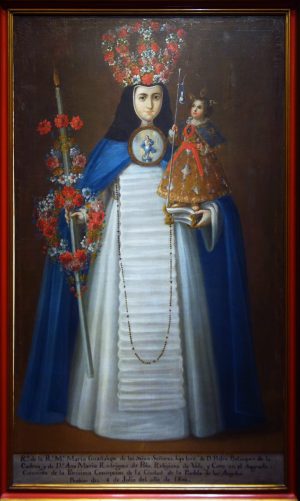
Crowned Nun Portrait of Sor María de Guadalupe, c. 1800, oil on canvas (Banamex collection, Mexico City)
Imagine you are getting married and you want to look your best—maybe you’d wear some jewelry, coif your hair, and of course, try to find a fashionable outfit. But what if the person you intended to marry was not physically present and the marriage was a spiritual one, say a young woman who was committing her life to God by taking vows as a nun—what might that wedding outfit look like?
If you were a nun in 18th-century Mexico, it is possible that you looked like Sor María de Guadalupe. On the day you took your vows to become a nun and spiritual bride of Christ, your family paid to dress you in a large gown, a floral crown, and other elaborate textiles. You might also carry a palm frond, a candle, or a doll of the infant Jesus. Most noticeable, you might wear a large round piece of jewelry known as an escudo de monja—a nun’s badge. Heck, you might even get to wear two!
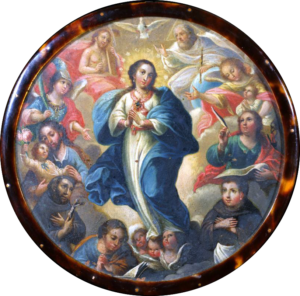
Artist currently unknown, escudo de monja, 18th century, Oil on copper with tortoise frame, 5.9 cm in diameter (San Antonio Museum of Art)
Numerous portraits of nuns show them wearing escudos as part of their profession, but numerous escudos also survive. They were common among nuns of the Conceptionist and Jeronymite orders, and some were made by the best artists of New Spain. The tradition may have originated in Spain and then came to the Americas, but the Spanish counterparts are not nearly as fanciful nor elaborate. In New Spain particularly, the tradition developed in new ways. Escudos are painted on copper and other metals, as well as vellum but they were also embroidered. Some have elaborate frames made of tortoiseshell or mother-of-pearl, others are made of wood with inlay or even silver. The paint could be oil or watercolor, depending on the support.
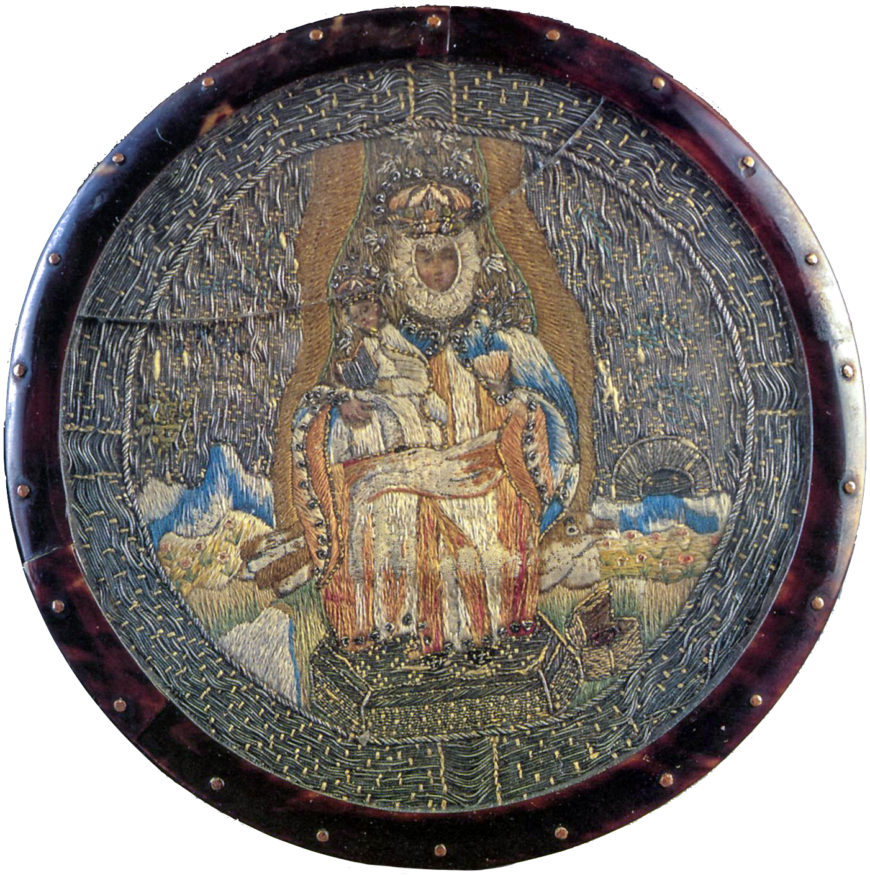
Escudo de monja with the Virgin of Balvanera, 18th century, silk, silver thread, thread, embroidery, tortoise shell, 18 x 1 cm, Mexico (Franz Mayer Museum, Mexico City)
In one lovely example from the Franz Mayer Museum in Mexico City, the artist embroidered the Virgin of Balvanera with silver thread and silk, all of it held together in its tortoiseshell frame. The luster of the silver and silk would have accentuated the nun’s presence as she took her vows as the bride of Christ. Escudos are bigger than you might imagine given that they are something worn on the chest or shoulder. They average 16–18 cm in diameter, and are attached with clips or cords. Escudos were a type of religious jewelry that was meant to be seen—and in portraits, you can’t miss them!
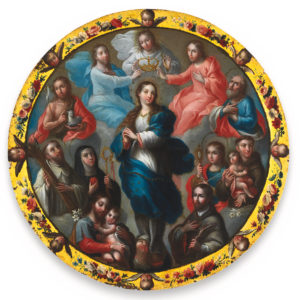
José de Páez, escudo de monja with the Immaculate Conception and saints, c. 1770, oil on copper, 17.8 cm in diameter, Mexico (LACMA)
Beyond their size and interesting materials, the escudo’s painted or embroidered surface included holy figures—sometimes many of them. While the Virgin of Balvanera escudo includes only two figures (Mary and the Christ Child), many escudos include the Virgin Mary surrounded by a gathering of saints of differing eras, or what is called a sacra conversazione, a “sacred conversation” of holy figures. In one escudo made by José de Páez, the Virgin Mary stands in the center, with her hands clasped in pious reverence. The Trinity, here shown as identical triplets, crown her as the Queen of Heaven. Floating on clouds around her are saints (see the diagram below), including Gertrude of Helfta, Joseph holding the Christ Child , John Nepomuk (more on this figure below), and John the Baptist with a lamb. The golden frame has flowers and cherubs painted on it to add further visual interest and luster to the painted surface on copper. The flowers are roses, carnations, and lilies, which symbolize Mary’s purity. Looking inward toward Mary, the cherubs also help focus attention on Mary as the primary focus of the scene.
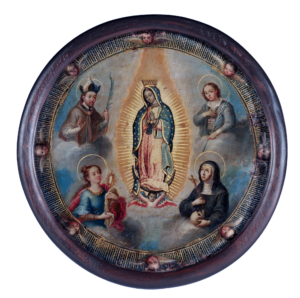
Francisco Martínez, Virgin of Guadalupe with Saints (nun’s badge), 18th century, oil and gold leaf on copper with glass and tortoise-shell frame, diameter: 21.27 cm (Denver Art Museum)
Here, the Virgin Mary is shown in the guise of the Virgin of the Immaculate Conception, with her white dress and blue mantle. The Immaculate Conception highlighted Mary’s purity—that she was conceived immaculately within her mother’s womb without sin. Escudos often show the Immaculate Conception, but we also do see variation, such as the Annunciation or even the Virgin of Guadalupe. The focus, though, was always on an advocation (version of Mary) of the Virgin Mary.
After a nun’s profession, it is possible that their escudos became devotional aids to prayer. Regardless of how they functioned though, they were prestige items. They emphasized a Christian nun’s piety and role as a bride of Christ, but they also advertised her wealth and by extension her family’s—a family that could afford to commission some of the best artists in New Spain to create objects that used sumptuous materials found locally as well as imported: silk from Asia, and silver and tortoiseshell found in different regions of Mexico.
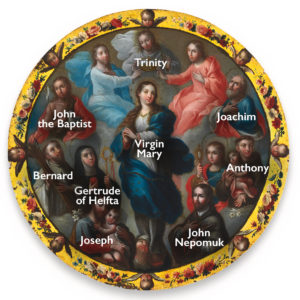
José de Páez, escudo de monja with the Immaculate Conception and saints, c. 1770, oil on copper, 17.8 cm in diameter, Mexico (LACMA)
Badges of Jesuit support?
The incorporation of John of Nepomuk raises the issue of whether this badge communicated a political and religious message because this saint was one especially championed by the Jesuits. The Society of Jesus, whose members were known as the Jesuits, had been expelled from Spain and all its dominions in 1767, despite being well-supported by many members of New Spanish society. As a result, many people who continued to support the Jesuits and their religious devotions did so via visual imagery, including with saints and other icons that had clear resonances with the Jesuits.
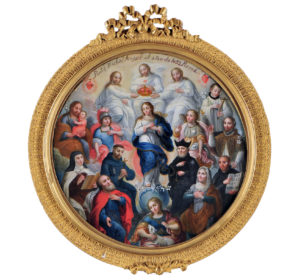
José María Vázquez, escudo de monja with Immaculate Conception and saints, and the Sacred Heart of Jesus (upper left) and the Immaculate Heart of Mary (upper right), 18th–19th century, oil on copper, 23.5 x 21 cm (Museo Amparo, Puebla)
John of Nepomuk was one of these figures. He was a 14th-century saint from Prague who was associated with the act of confession, which the Jesuits actively encouraged people to do. Leading up to and after their expulsion, the incorporation of John Nepomuk in art assumed a new meaning as an act of resistance to the Spanish Crown’s dislike of the Jesuits, and the eventual decision to expel the Jesuits and then dissolve them as a religious order by 1773. Some scholars suggest that the inclusion of John Nepomuk on badges signaled nuns’ support of the Jesuits.
Many badges also show the Sacred Heart of Jesus, another Catholic icon widely supported by the Jesuits that consists of a naturalistic rendering of the heart of Jesus encircled by a crown of thorns, a bleeding wound, and crucifix rising from it. Its appearance, sometimes accompanied by Mary’s Immaculate Heart, is more evidence that nuns were actively continuing to sponsor Jesuit devotions in the wake of the order’s suppression. This is not to say that all escudos clearly espoused Jesuit devotion, but it is notable that many do.
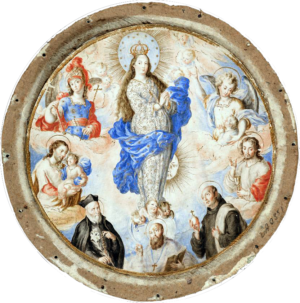
Juan Rodríguez Juárez, escudo de monja with the Immaculate Conception and saints, c. 1725, watercolor and mixed media on parchment, mounted on cardboard (Hispanic Society and Library)
Sumptuary laws and religious jewelry
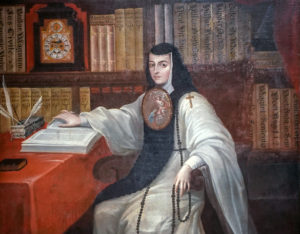
Miguel Cabrera, Portrait of Sor Juana Inés de la Cruz (detail), c. 1750, oil on canvas (Museo Nacional de Historia, Castillo de Chapultepec, Mexico)
In New Spanish society, there was concern over lavish adornment (in public especially) because it would seem immodest and indecorous, and so less Christian. In an attempt to legislate what people (particularly women), could wear in public, sumptuary laws set limits on the amount of jewelry and luxurious accouterments. In reality, people often found ways around sumptuary laws, and it is possible that escudos developed as one way for women in the convent to circumvent them as well. Certain religious orders were extremely wealthy, including the Conceptionists and Jeronymites, so perhaps it is understandable why nuns of these orders favored escudos. While nuns could not marry or have children and they might be cloistered inside a convent, those belonging to wealthier orders could still maintain a comfortable lifestyle. Some nuns had libraries, servants, and musical instruments, among other things. The famed Jeronymite nun Sor Juana Inés de la Cruz had a vast library that permitted her to continue living as one of the premier intellectuals and poets of her day.
Escudos perhaps avoided sumptuary legislation because they are not typical jewelry worn by most, nor are they solely made of expensive materials like gold and silver. Their painted or embroidered imagery is also devotional in nature, and so they served a particular function. The wealthy lifestyle of some female religious orders was eventually targeted for reform in the late 18th century, and it is around this time that escudos became less popular as a genre of art.
Escudos de monjas are an important genre of art made in the viceroyalty of New Spain, one that gives us a glimpse into how nuns fashioned themselves.
Additional resources
Virginia Armella de Aspe and Guillermo Tovar de Teresa, Escudos de Monjas Novohispanas (Mexico City: Grupo Gusta, 1993).
Miguel A. Bretos et al., Retratos: 2,000 Years of Latin American Portraits (San Antonio Museum of Art, 2004).
James Córdova, The Art of Professing in Bourbon Mexico: Crowned-Nun Portraits and Reform in the Convent (Austin: University of Texas, 2014)
Cristina Cruz González, “The Balvanera Escudo,” Object Narrative, in Conversations: An Online Journal of the Center for the Study of Material and Visual Cultures of Religion (2014), doi:10.22332/con.obj.2014.50.
Martha Egan, Relicarios: Devotional Miniatures from the Americas (Museum of New Mexico Press, 1993).
Lauren Kilroy-Ewbank, Holy Organ Or Unholy Idol? The Sacred Heart in the Art, Religion, and Politics of New Spain (Leiden: Brill, 2019).
Elizabeth Perry, “Escudos de Monjas/Shields of Nuns: The Creole Convent and Images of Mexican Identity in Miniature” (Ph.D. diss., Brown University, 1999).
Elizabeth Perry, “Convents, Art, and Creole Identity in Late Viceregal New Spain,” in Women and Art in Early Modern Latin America (Leiden: Brill Publishers, 2007).
Donna Pierce, Clara Bargellini, Rogelio Ruiz Gomar, Painting a New World: Mexican Art and Life, 1521–1821 (Denver Art Museum, 2004).
Antonio Rubial García and Doris Bieñko De Peralta, “La más amada de Cristo: Iconografía y culto de santa Gertrudis la Magna en la Nueva España,” Anales del Instituto de Investigaciones Estéticas XXV, no. 83 (2003), pp. 5–54.

